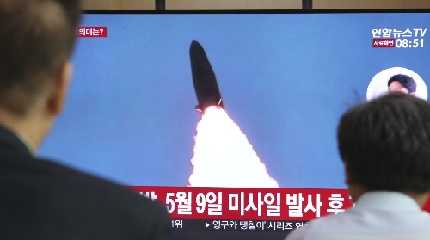
SEOUL, March 25 (Reuters) - North Korea's latest launch was a big, new intercontinental ballistic missile (ICBM), state media reported on Friday, a test leader Kim Jong Un said was designed to demonstrate the might of its nuclear force and deter any U.S. military moves.
Thursday's launch was the first full ICBM test by nuclear-armed North Korea since 2017. Flight data indicated the missile flew higher and longer than any of North Korea's previous tests before crashing into the sea west of Japan.
What North Korea calls the Hwasong-17 would be the largest liquid-fuelled missile ever launched by any country from a road-mobile launcher, analysts say.
Its range and size suggest North Korea plans to tip it with multiple warheads that could hit several targets or with decoys to confuse missile defences, they say.
The leaders of the Group of Seven industrialised nations and the European Union condemned North Korea's test as a "reckless" threat to peace and security and a danger to international civil aviation and maritime navigation. They said it demanded a united response.
North Korea's last ICBM launches in 2017 prompted U.N. Security Council sanctions, but council members are at odds over the Ukraine war, making such a response more difficult.
The Security Souncil is due to meet to discuss the launch later on Friday at the request of the United States and allies. On Thursday, Secretary-General Antonio Guterres urged North Korea "to desist from taking any further counter-productive actions".
Russia's RIA news agency quoted the Russian foreign ministry as saying that Russia and China had agreed to coordinate closely on the situation on the Korean peninsula.
"Concern was expressed over the latest developments in the sub-region" at a meeting between Russian Deputy Foreign Minister Igor Morgulov and China's representative for the Korean Peninsula, it said, adding that they emphasised the need to step up efforts towards fair political and diplomatic solutions for the problems of northeast Asia.
North Korean state media said Kim ordered the test because of "daily-escalating military tension in and around the Korean peninsula" and the "inevitability of the long-standing confrontation with the U.S. imperialists accompanied by the danger of a nuclear war".
"The strategic forces ... are fully ready to thoroughly curb and contain any dangerous military attempts of the U.S. imperialists," Kim said while overseeing the launch.
North Korea's return to testing weapons experts believe are capable of striking the United States is an unwelcome additional challenge to President Joe Biden as he responds to Russia's invasion of Ukraine.
It comes after the election of a new, conservative South Korean administration that has pledged a more muscular military strategy towards North Korea.
President-elect Yoon Suk-yeol said North Korea had nothing to gain from provocation.
In a call with Chinese President Xi Jinping after the launch, Yoon called for close coordination on North Korea's complete denuclearisation, his office said. Xi said Beijing and Seoul should bolster mutual political trust, Chinese state media said.
China, North Korea's sole major ally and neighbour, urged restraint on "all sides" after the test.
South Korea staged an exercise with F-35 fighter jets on Friday.
Kim said the test would help convince the world of the power of his strategic forces.
"Any forces should be made to be well aware of the fact that they will have to pay a very dear price before daring to attempt to infringe upon the security of our country," he said.
A spokesperson for the White House, asked about Kim's remarks, said it had nothing to add to its earlier condemnation of the launch.
'STRIKING DEMONSTRATION'
The U.S. State Department announced sanctions on Thursday on two Russian companies, a Russian and a North Korean individual, and North Korea’s Second Academy of Natural Science Foreign Affairs Bureau for transferring sensitive items to North Korea’s missile programme.
North Korean state media showed a massive missile, painted black with a white nosecone, rising on a column of flame from a launch vehicle.
It said the Hwasong-17 flew for 1,090 km (680 miles) to an altitude of 6,248.5 km (3,905 miles) and hit a target in the sea, similar numbers to those reported by Japan and South Korea.
NK Pro, a Seoul-based website that monitors North Korea, said discrepancies in the imagery and video released by state media suggested that it may have been shot on different dates, raising the possibility that North Korea was hiding details.
North Korea never acknowledged what South Korea said was a failed launch from the same airport last week, and on Thursday South Korea's Yonhap news agency cited unnamed officials who said they were examining whether the latest test may have been a smaller Hwasong-15 ICBM, which was test fired in November 2017.
Officials in Seoul and Washington previously said launches on Feb. 27 and March 5 involved parts of the Hwasong-17 ICBM system, likely in preparation for a full test.
KCNA called Thursday's test a "striking demonstration of great military muscle".
Kim, who the state broadcaster showed in video at the launch site dressed in a leather jacket and sunglasses, called it a "miraculous" and "priceless" victory for the Korean people.




